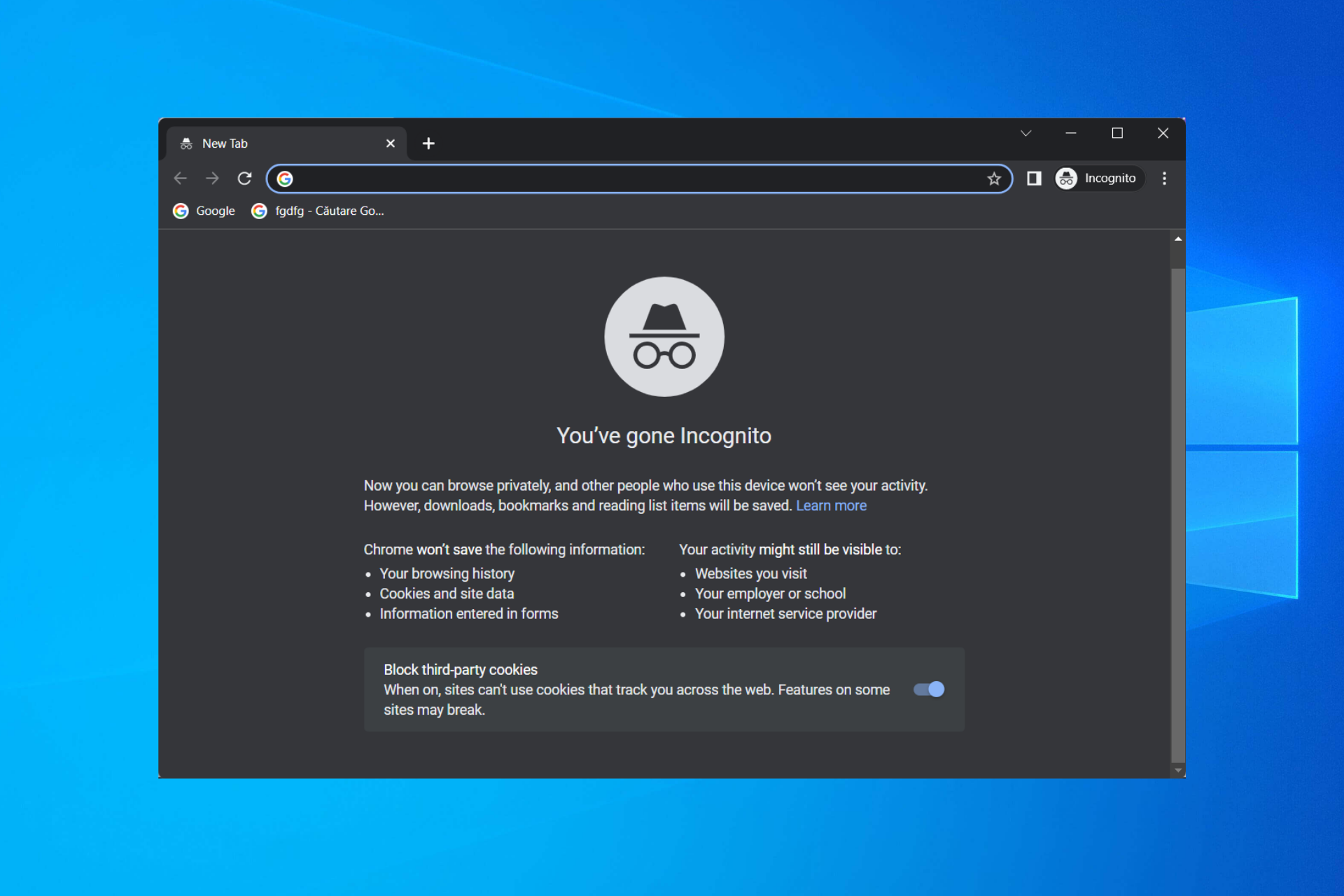In today's digital age, online privacy has become a crucial concern for internet users worldwide. With the rise of data breaches, targeted advertisements, and surveillance, many people are turning to tools like incognito mode to protect their personal information. However, understanding the limitations and proper usage of incognito mode is essential for maintaining your digital security. This comprehensive guide will explore everything you need to know about incognito mode, its benefits, limitations, and how to effectively manage your online privacy.
The phrase "get out if incognito" has become increasingly relevant as users navigate the complex world of digital privacy. Many people mistakenly believe that incognito mode offers complete anonymity online, but this couldn't be further from the truth. In this article, we'll delve into the reality of incognito browsing, exploring what it can and cannot do while providing practical advice for maintaining your online privacy.
As we progress through this guide, you'll discover how incognito mode works across different browsers, its limitations in protecting your data, and alternative methods for enhancing your online privacy. We'll also discuss the implications of your digital footprint and provide expert recommendations for managing your online presence effectively. Whether you're a casual internet user or someone who values their digital privacy, this article will equip you with the knowledge to make informed decisions about your online activities.
Read also:Girthmaster And Miaz Video A Comprehensive Guide To Understanding And Exploring
Table of Contents
- What is Incognito Mode?
- How Incognito Mode Works Across Different Browsers
- Limitations of Incognito Mode
- Alternatives to Incognito Mode
- Enhancing Your Data Security
- Essential Privacy Tools and Extensions
- Managing Your Digital Footprint
- Understanding VPN Solutions
- Optimizing Privacy Settings
- Best Practices for Online Privacy
What is Incognito Mode?
Incognito mode, also known as private browsing, is a feature available in most modern web browsers that allows users to browse the internet without storing local data about their session. This feature was initially introduced to help users maintain privacy while using shared or public computers. When you activate incognito mode, your browser creates a temporary session that doesn't save your browsing history, cookies, or site data after you close the window.
Key Features of Incognito Mode
- Doesn't save browsing history
- Prevents cookies from being stored locally
- Blocks third-party cookies by default
- Disables browser extensions
- Creates a separate browsing session
Common Misconceptions About Incognito Mode
Many users mistakenly believe that incognito mode makes them completely anonymous online. However, it's crucial to understand that while incognito mode prevents your local device from storing browsing data, it doesn't hide your activities from:
- Your Internet Service Provider (ISP)
- Websites you visit
- Network administrators
- Government agencies
How Incognito Mode Works Across Different Browsers
While the fundamental concept of incognito mode remains consistent across browsers, there are subtle differences in how each browser implements this feature. Understanding these variations can help you make more informed decisions about your privacy.
Google Chrome
Chrome's incognito mode, activated by pressing Ctrl+Shift+N (Windows) or Cmd+Shift+N (Mac), offers robust protection against local data storage. It automatically blocks third-party cookies and prevents extensions from running unless specifically allowed. Chrome also provides clear visual indicators when you're in incognito mode, with a distinctive dark theme and an incognito icon in the corner.
Mozilla Firefox
Firefox's Private Browsing mode, accessible through Ctrl+Shift+P (Windows) or Cmd+Shift+P (Mac), goes a step further by incorporating tracking protection. This feature blocks known trackers from following your online activities, providing an additional layer of privacy. Firefox also offers enhanced privacy features through its Enhanced Tracking Protection settings.
Safari
Safari's Private Browsing mode, activated through Safari's File menu, offers similar functionality to other browsers while integrating seamlessly with Apple's ecosystem. It prevents websites from tracking your IP address across different websites and blocks social media trackers. Safari's Intelligent Tracking Prevention system works in conjunction with private browsing to enhance user privacy.
Read also:Andie Elle The Rising Star In The Music Industry
Limitations of Incognito Mode
Understanding the limitations of incognito mode is crucial for maintaining realistic expectations about your online privacy. While incognito mode offers valuable protection against local data storage, it doesn't provide complete anonymity or security.
What Incognito Mode Can't Protect You From
- Your ISP can still track your browsing activities
- Websites you visit can log your IP address
- Employers or school administrators can monitor network traffic
- Government agencies can access your browsing data
- Malware and viruses can still infect your device
Technical Limitations of Incognito Mode
From a technical perspective, incognito mode primarily affects local data storage and doesn't implement any network-level protection. This means that:
- All data transmitted between your device and websites remains visible
- DNS queries are still visible to your ISP
- Your IP address remains exposed to websites
- Downloaded files are still stored on your device
Alternatives to Incognito Mode
For users seeking more comprehensive privacy protection, several alternatives to incognito mode offer enhanced security features and better protection against various tracking methods.
Virtual Private Networks (VPNs)
VPNs create encrypted tunnels between your device and the internet, masking your IP address and encrypting your internet traffic. This makes it significantly more challenging for third parties to track your online activities. Popular VPN services include:
- ExpressVPN
- NordVPN
- Surfshark
Tor Browser
The Tor network provides one of the most secure methods for anonymous browsing. By routing your traffic through multiple nodes worldwide, Tor makes it extremely difficult to trace your online activities back to your original IP address. While slower than regular browsing, Tor offers unparalleled anonymity.
Privacy-Focused Browsers
Several browsers are specifically designed with privacy in mind:
- Brave Browser
- DuckDuckGo Privacy Browser
- Epic Privacy Browser
Enhancing Your Data Security
While incognito mode provides basic protection against local data storage, implementing additional security measures can significantly enhance your overall data security.
Two-Factor Authentication (2FA)
Implementing 2FA adds an extra layer of security to your online accounts. Even if someone gains access to your password, they would need the second authentication factor to access your account.
Secure Password Management
Using a password manager helps create and store complex, unique passwords for each of your accounts. Popular password managers include:
- LastPass
- 1Password
- Bitwarden
Data Encryption Tools
Encrypting your sensitive data adds another layer of protection against unauthorized access. Tools like VeraCrypt and BitLocker provide robust encryption solutions for your files and drives.
Essential Privacy Tools and Extensions
Beyond incognito mode, several tools and browser extensions can enhance your online privacy and protect your personal information.
Privacy-Focused Browser Extensions
- uBlock Origin - Advanced ad blocker
- HTTPS Everywhere - Forces HTTPS connections
- Privacy Badger - Blocks invisible trackers
- Decentraleyes - Protects against CDN tracking
Anti-Tracking Tools
Specialized tools can help prevent websites from tracking your online activities:
- Ghostery
- Disconnect
- TrackMeNot
Search Engine Alternatives
Privacy-focused search engines provide an alternative to traditional search engines that track your queries:
- DuckDuckGo
- Startpage
- Qwant
Managing Your Digital Footprint
Your digital footprint encompasses all the information about you that exists online, whether you've actively shared it or not. Effectively managing your digital footprint is crucial for maintaining your online privacy and security.
Steps to Minimize Your Digital Footprint
- Regularly review and adjust privacy settings on social media platforms
- Use privacy-focused email services
- Limit sharing personal information online
- Regularly search for your name online and request removal of unwanted information
Understanding Data Collection Practices
Many online services collect extensive data about their users, including:
- Browsing history
- Location data
- Device information
- Behavioral patterns
Understanding VPN Solutions
Virtual Private Networks (VPNs) provide one of the most effective ways to enhance your online privacy and security beyond what incognito mode offers.
How VPNs Work
VPNs create encrypted connections between your device and a remote server, masking your IP address and encrypting your internet traffic. This makes it significantly more challenging for third parties to track your online activities or intercept your data.
Choosing the Right VPN
When selecting a VPN service, consider the following factors:
- No-logging policy
- Server locations
- Connection speed
- Device compatibility
- Customer support
Optimizing Privacy Settings
Properly configuring your device and browser settings can significantly enhance your online privacy and security.
Browser Privacy Settings
- Enable Do Not Track requests
- Block third-party cookies
- Disable location tracking
- Use strict tracking protection
Operating System Privacy Settings
Both Windows and macOS offer extensive privacy settings that can be adjusted to enhance your security:
- Limit ad tracking
- Manage app permissions
- Control diagnostic data sharing
- Enable firewall protection
Best Practices for Online Privacy
Maintaining your online privacy requires a combination of technical measures and behavioral adjustments. Here are some essential best practices:
Regular Security Audits
- Review connected apps and services regularly
- Check for unauthorized account access
- Monitor your credit reports
- Update software and security patches
Safe Browsing Habits
Developing safe browsing habits can significantly reduce your risk of privacy breaches:
- Verify website security (look for HTTPS)
- Avoid clicking suspicious links
- Be cautious with public Wi-Fi networks
- Use bookmarked links for sensitive sites
Education and Awareness
Staying informed about the latest privacy threats and protection methods is crucial for maintaining your online security:
- Follow reputable cybersecurity news sources
- Participate in privacy awareness training
- Understand common phishing techniques
- Learn about emerging privacy technologies
In conclusion, while incognito mode provides valuable protection against local data storage, it's essential to understand its limitations and

